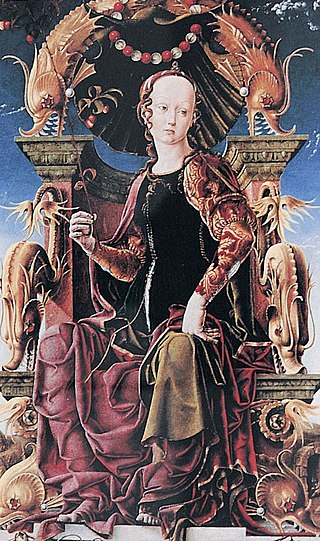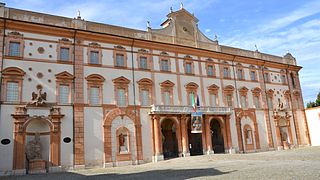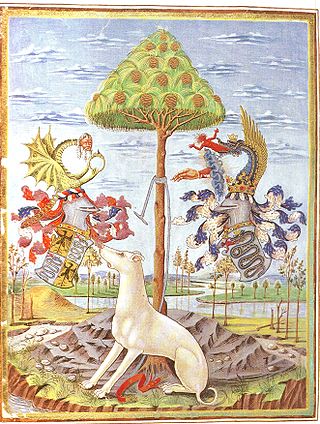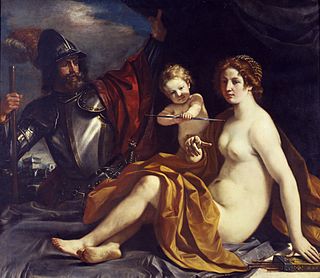Related Research Articles

The House of Este is a European dynasty of North Italian origin whose members ruled parts of Italy and Germany for many centuries.

Modena is a city and comune (municipality) on the south side of the Po Valley, in the Province of Modena, in the Emilia-Romagna region of northern Italy.

The Duchy of Modena and Reggio was an Italian state created in 1452 located in Northwestern Italy, in the present day region of Emilia-Romagna. It was ruled since its establishment by the noble House of Este, and since 1814 by the Austria-Este branch of the family. The Este dynasty was a great sponsor of the arts, making the Duchy a cultural reference during the Renaissance and Baroque periods.

This is a list of rulers of the estates owned by the Este family, which main line of Marquesses rose in 1039 with Albert Azzo II, Margrave of Milan. The name "Este" is related to the city where the family came from, Este.

Benvenuto Tisi was a Late-Renaissance-Mannerist Italian painter of the School of Ferrara. Garofalo's career began attached to the court of the Duke d'Este. His early works have been described as "idyllic", but they often conform to the elaborate conceits favored by the artistically refined Ferrarese court. His nickname, Garofalo, may derive from his habit of signing some works with a picture of a carnation.

Cosmê Tura, also known as Il Cosmè or Cosimo Tura, was an Italian early-Renaissance painter and considered one of the founders of the School of Ferrara.

Palazzo Schifanoia is a Renaissance palace in Ferrara, Emilia-Romagna (Italy) built for the Este family. The name "Schifanoia" is thought to originate from "schifare la noia" meaning literally to "escape from boredom" which describes accurately the original intention of the palazzo and the other villas in close proximity where the Este court relaxed. The highlights of its decorations are the allegorical frescoes with details in tempera by or after Francesco del Cossa and Cosmè Tura, executed ca 1469–70, a unique survival of their time.

The Castello Estense or castello di San Michele is a moated medieval castle in the center of Ferrara, northern Italy. It consists of a large block with four corner towers.

Palazzo dei Diamanti is a Renaissance palace located on Corso Ercole I d'Este 21 in Ferrara, region of Emilia Romagna, Italy. The main floor of the Palace houses the Pinacoteca Nazionale di Ferrara.

The Ducal Palace in Sassuolo is a Baroque villa located in the town of Sassuolo, thirty minutes outside Modena, northern Italy.

The Biblioteca Estense, was the family library of the marquises and dukes of the House of Este. The exact date of the library's birth is still under speculation, however it is known for certain that the library was in use during the fourteenth century. Whilst it was greatly enriched during the Renaissance years in Ferrara, the library was concretely established in Modena in the beginning of the seventeenth century. It is known as one of the most important libraries in Italy. The library is located, along with the Galleria Estense directly below its collection of artworks, in the Palazzo dei Musei in Modena.

The Galleria Estense is an art gallery in the heart of Modena, centred around the collection of the d’Este family: rulers of Modena, Reggio and Ferrara from 1289 to 1796. Located on the top floor of the Palazzo dei Musei, on the St. Augustine square, the museum showcases a vast array of works ranging from fresco and oil painting to marble, polychrome and terracotta sculpture; musical instruments; numismatics; curios and decorative antiques.
The Studiolo of the Palazzo Belfiore was a former study, or room for intellectual pursuits, that was once found in a razed Renaissance palace in Ferrara, region of Emilia-Romagna, Italy. While the palace has disappeared, records do list the paintings, consisting of depictions of muses, that hung in the room. These secular works are now dispersed across museums, but their collective presences recall the renewed attention of Renaissance patrons to symbols from classic mythology.

The Pinacotecta Nazionale is an art gallery in Ferrara, Emilia-Romagna, Italy. It is located on the piano nobile of the Palazzo dei Diamanti, a work of Renaissance architecture by Biagio Rossetti, commissioned by Leonello d’Este in 1447. Not to be confused with the Civic Museum on the lower floor, which has hosted temporary exhibitions of contemporary art since 1992, the Pinacoteca houses a collection of paintings by the Ferrarese School dating from the thirteenth to the eighteenth centuries. It was founded in 1836 by the Municipality of Ferrara after Napoleon's widespread dissolution of churches threatened the protection of important public artworks. The gallery is formed as much around notable northern Italian painters as it is around the exquisite interior decoration of the palace itself, together with remnants of frescoes from local churches and later acquisitions from the Sacrati Strozzi collection.

The Estense Lapidary Museum is a lapidarium-museum in Modena, Italy, located around the interior quadrangle of the Palazzo dei Musei's ground floor. It is owned by the province of Modena and the Gallerie Estensi. As the first public museum to be commissioned by the Duke Francesco IV d'Este upon his re-entry into Modena in 1814, it stands as a symbol of the collaboration between church, state and nobility. It also marks a new direction for the city of Modena, one recognising its rich historical identity.

The Castle of the Pico is a castle in the city center of Mirandola, in the province of Modena, Italy.

The Civic Museum of Mirandola is a museum housed in the castle of the Pico in Mirandola, in the province of Modena, Italy, dedicated to the archaeology of the territory, religious commissions, ancient furnishings and paintings, coins and medals of the ancient mint of Mirandola. The museum is also enriched by maps from the 16th to the 20th century, various items from the ancient Mount of Piety of the Franciscan friars and a collection of military relics.

Venus, Cupid and Mars is a 1633 oil-on-canvas painting by the Italian Baroque painter Guercino, commissioned by Francesco I d'Este for his Ducal Palace of Sassuolo around 1632–1633, when the artist was in that city to paint portraits of the d'Este family. It is now in the Galleria Estense in Modena.

The Municipal Palace of Ferrara is located in Piazza del Municipio 2. It was the ducal residence of the Este family until the 16th century, when the court moved to the nearby Castello Estense. It is the seat of the municipality of Ferrara.

The ‘‘‘Ducal Palace of Rivalta’’’ was a baroque palace in Rivalta, just south of Reggio Emilia, Itay. The palace and its park were inspired by the Palace of Versailles. Until 1796, it served as a residence of the dukes of Modena from the House of Este, after which it fell in disrepair. Today, only the southern wing remains.
References
- ↑ "Mission & Vision". www.gallerie-estensi.beniculturali.it. Retrieved 2019-07-24.
- ↑ Casciu, Stefano (2015). La Galleria Estense. Modena: Franco Cosimo Panini.
- ↑ Giordani, Nicoletta (2003). Museo Lapidario Estense. Modena: Edizioni Il Fiorino. pp. 5–23.
- 1 2 3 Milano, Ernesto (1987). Biblioteca Estense di Modena. Firenze: Nardini Editore. pp. 13–245.
- ↑ Bentini, Jadranka (1992). Pinacoteca Nazionale di Ferrara - Exhibition catalogue. Bologna: Nuova Alfa Editoriale. pp. 9–30. ISBN 88-7779-292-2.
- ↑ Gallerie Estensi, "Palazzo Ducale di Sassuolo App," Apple App Store, Vers.1.5 (May 2018)